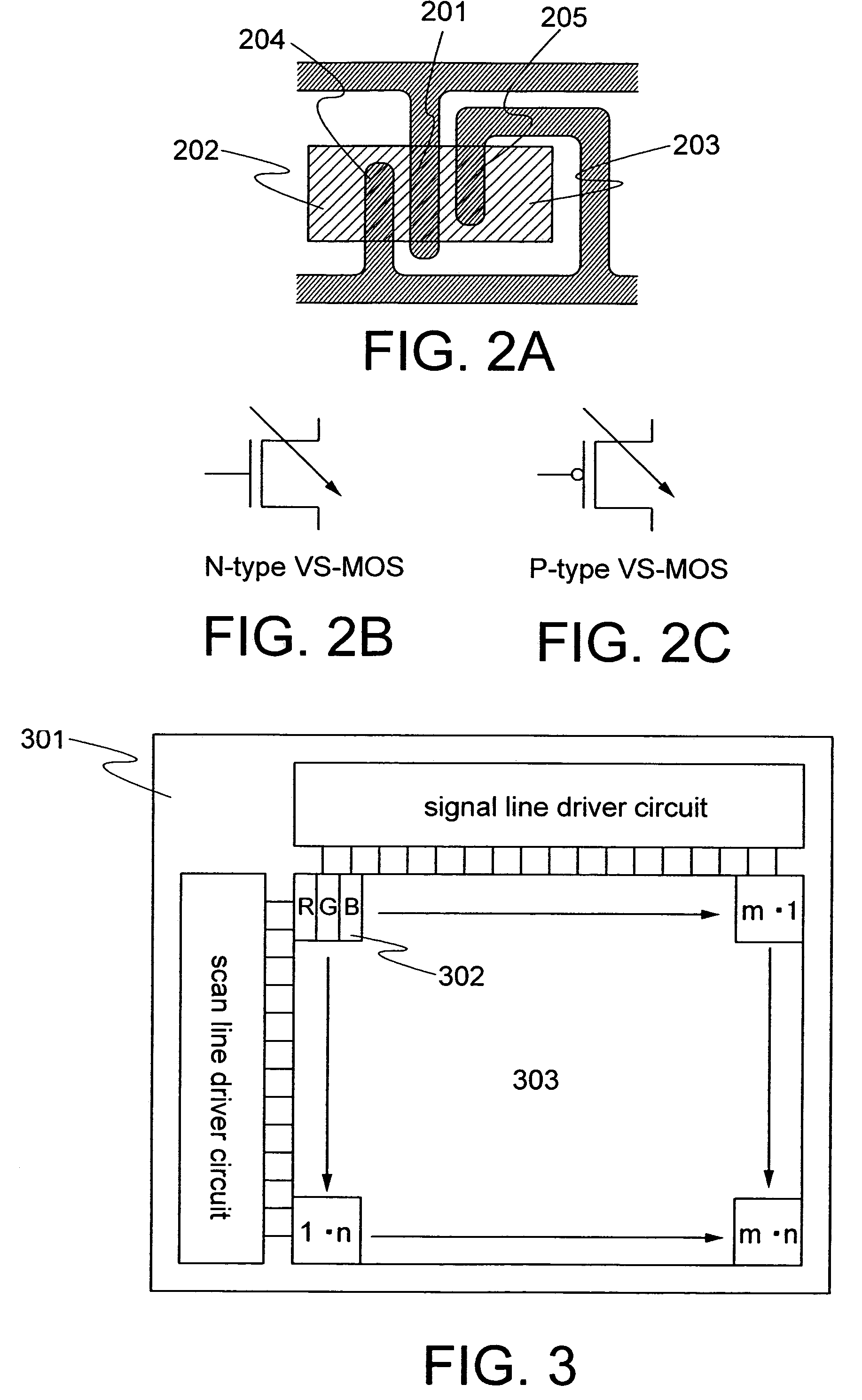Display device
a display device and display technology, applied in semiconductor devices, transistors, instruments, etc., can solve the problems of increasing achieve the effect of reducing cost and power consumption, improving gray scale reproducibility and color reproducibility, and improving color reproducibility
- Summary
- Abstract
- Description
- Claims
- Application Information
AI Technical Summary
Benefits of technology
Problems solved by technology
Method used
Image
Examples
embodiment mode 1
[0030]First, an example of a schematic layout of a VS-MOS and circuit symbols are shown in FIGS. 2A to 2C. As shown in the drawings, a VS-MOS comprises a control gate 204 between a main gate 201 and a source region 202, and a control gate 205 between the main gate 201 and a drain region 203. In the VS-MOS having such a structure, when varying a voltage applied to the control gates 204 and 205, it is possible to change a current value flowing between the source region 202 and the drain region 203 without varying a voltage applied to the main gate 201.
[0031]Next, shown in FIG. 3 is a structure of a display device in which the VS-MOS is used for a transistor for driving a light emitting element. A display device comprises over a substrate 301 a pixel portion 303 that includes m×n pixels 302 arranged in matrix. Each of the pixels 302 includes three sub-pixels each corresponding to one of RGB. It is noted that the sub-pixels correspond to the ones formed of light emitting elements using ...
embodiment mode 2
[0037]In the invention, a transistor obtained in manufacturing steps described below can be employed. Described hereinafter are manufacturing steps of a VS-MOS.
[0038]A droplet ejection method here means a method typified by an inkjet method and a dispenser method.
[0039]A composition containing a conductive material is ejected onto a substrate 401 by the droplet ejection method to form a conductive layer 402 functioning as a gate electrode and conductive layers 403 functioning as control gates (see FIG. 4A).
[0040]Then, an insulating layer 404 functioning as an insulating film is formed. The insulating layer 404 may be formed of a single layer or a plurality of stacked layers. Further, an I-type amorphous silicon layer 405 and an N-type amorphous silicon layer 406 are formed. Subsequently, the I-type amorphous silicon layer 405 and the N-type amorphous silicon layer 406 are patterned using a resist or the like used as a mask, then the resist or the like used as a mask is removed (see ...
embodiment mode 3
[0047]A pixel circuit using the invention is described with reference to FIGS. 6A and 6B. FIG. 6A shows an area surrounded by a signal line 6114, power source lines 6115 and 6117, and a scan line 6116, which includes a transistor 6110 for controlling a video signal input to a pixel 6101, a transistor 6111 for controlling a current value flowing into a light emitting element 6113, a control gate signal line 6100 for supplying a signal to a control gate of the transistor 6111, and a capacitor 6112 for holding a gate-source voltage of the transistor 6111. It is noted that a gate capacitance or other parasitic capacitance of the transistor 6111 may be used instead of the capacitor 6112.
[0048]FIG. 6B shows a pixel circuit in which a transistor 6118 and a scan line 6119 are additionally provided in the pixel 6101 shown in FIG. 6A. The transistor 6118 makes a state in which a current supply to the light emitting element 6113 is forcibly stopped. Therefore, a lighting time can be started si...
PUM
 Login to View More
Login to View More Abstract
Description
Claims
Application Information
 Login to View More
Login to View More - R&D
- Intellectual Property
- Life Sciences
- Materials
- Tech Scout
- Unparalleled Data Quality
- Higher Quality Content
- 60% Fewer Hallucinations
Browse by: Latest US Patents, China's latest patents, Technical Efficacy Thesaurus, Application Domain, Technology Topic, Popular Technical Reports.
© 2025 PatSnap. All rights reserved.Legal|Privacy policy|Modern Slavery Act Transparency Statement|Sitemap|About US| Contact US: help@patsnap.com



